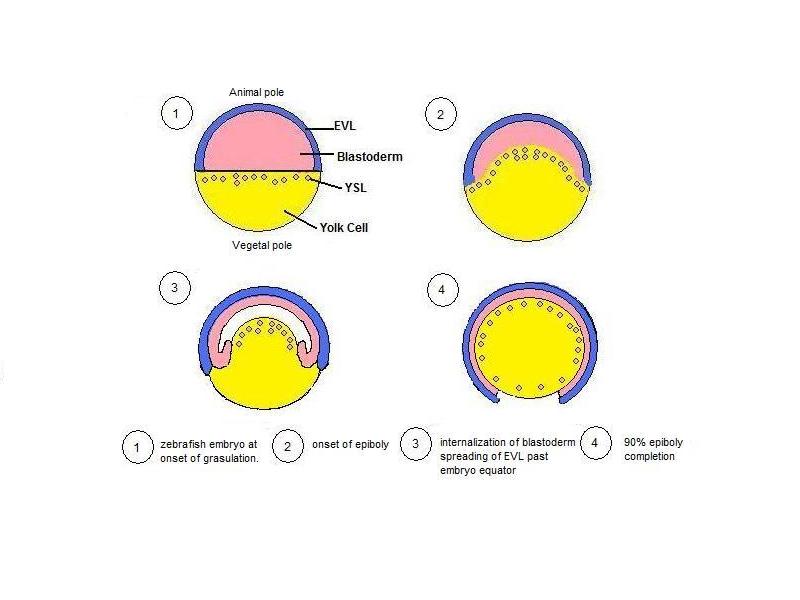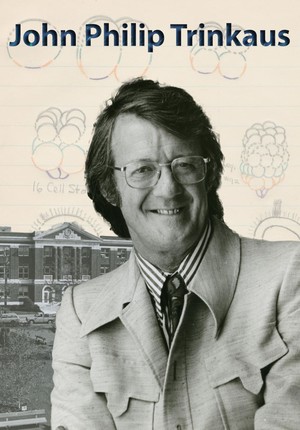Gastrulation is a fundamental process that occurs during early embryonic development (Keller, Clark & Griffin 1991) through which a single-layered blastula transforms into a three-layered structure, referred to as the gastrula. The gastrula is comprised of three germ layers: the ectoderm, which gives rise to epidermis and, eventually, the nervous system; mesoderm, which develops into vertebrae, muscle, and connective tissue; and endoderm, which matures into the epithelium of the respiratory and digestive systems. The morphogenetic cell movements of gastrulation vary across the animal kingdom, but it includes five basic kinds of cell movements. All embryos can use that repertoire of gastrulation movements to reposition cells and create new tissues. One such movement is epiboly, which can be described as the flattening or spreading of a sheet of cells that cover the embryo. During epiboly, the cell layers thin out and spread across the yolk, positioning the ectoderm on top of the mesoderm. At the end of the complicated process of gastrulation, the embryo has achieved a basic body plan, which presents the initial conditions for organogenesis to take place.

- Atz, James W. "Fundulus heteroclitus in the laboratory: a history." American zoologist 26, no. 1 (1986): 111-120.
- Betchaku, Teiichi, and J. P. Trinkaus. “Programmed endocytosis during epiboly of Fundulus heteroclitus.” American zoologist 26, no. 1 (1986): 193-199.
- Davis, Edward M., and J. P. Trinkaus. "Significance of cell-to-cell contacts for the directional movement of neural crest cells within a hydrated collagen lattice." Journal of embryology and experimental morphology 63, no. 1 (1981): 29-51.
- DuPont, Ellen M. "John Philip Trinkaus (1918-2003)." Embryo Project Encyclopedia (2012).
- Goodrich, H. B., and J. P. Trinkaus. "The differential effect of radiations on mendelian phenotypes of the goldfish, Carassius auratus." The Biological Bulletin 77, no. 2 (1939): 192-199.
- Goodrich, H. B., and J. P. Trinkaus. "The differential effect of radiations on mendelian phenotypes of the goldfish, Carassius auratus." The Biological Bulletin 77, no. 2 (1939): 192-199.
- Goodrich, H. B., N. D. Josephson, J. P. Trinkaus, and Jeanne M. Slate. "The cellular expression and genetics of two new genes in Lebistes reticulatus." Genetics 29, no. 6 (1944): 584-592.
- Keller, Ray, Wallis H. Clark, and Frederick Griffin (Eds.) Gastrulation: Movements, Patterns, and Molecules. New York: Plenum Press, 1991.
- Kimmel, Charles B., and James A. Weston. "An overview of Trink's scientific accomplishments." Developmental Dynamics 228, no. 4 (2003): 586-587.
- Saunders, John W. "Trink, the man." Developmental Dynamics 228, no. 4 (2003): 588-590
- Schoenwolf, Gary C. "Trink: His life, his philosophy." Developmental Dynamics 228, no. 4 (2003): 591-593.
- Tickle, Cheryll A., and J. P. Trinkaus. "Change in surface extensibility of Fundulus deep cells during early development." Journal of cell science 13, no. 3 (1973): 721-726.
- Tickle, Cheryll A, and J. P. Trinkaus. "Observations on nudging cells in culture." Nature 261, no. 5559 (1976): 413-413.
- Trinkaus, J. Philip. "Factors concerned in the response of melanoblasts to estrogen in the Brown Leghorn fowl." Journal of Experimental Zoology 109, no. 1 (1948): 135-169.
- Trinkaus, John Philip. "The surface gel layer of Fundulus eggs in relation to epiboly." Proceedings of the National Academy of Sciences of the United States of America 35, no. 4 (1949): 218.
- Trinkaus, John Philip. "A study of the mechanism of epiboly in the egg of Fundulus heteroclitus." Journal of Experimental Zoology 118, no. 2 (1951): 269-319.
- Trinkaus, John Philip. "The differentiation of tissue cells." American Naturalist (1956): 273-289.
- Trinkaus, John Philip. “Procurement, maintenance and use of Fundulus eggs,” Methods in Developmental Biology. F.H. Wells and N.K. Wessells (Eds.) Crowell, New York: 1967, 113-122.
- Trinkaus, J. P. "The cellular basis of Fundulus epiboly. Adhesivity of blastula and gastrula cells in culture." Developmental biology 7 (1963): 513-532.
- Trinkaus, J. P. "Surface activity and locomotion of Fundulus deep cells during blastula and gastrula stages." Developmental biology 30, no. 1 (1973): 68-103.
- Trinkaus, J. P. "Mechanism of Fundulus epiboly—a current view." America n Zoologist 24, no. 3 (1984): 673-688.
- Trinkaus, John Philip. Cells into organs: the forces that shape the embryo. (2nd Ed.) New Jersey: Prentice-Hall, Inc., 1984.
- Trinkaus, John Philip. “Directional cell movement during early development of the teleost Blennius Pholis. I. Formation of epithelial cell clusters and their pattern and mechanism of movement.” Journal of Experimental Zoology 245 (1988a): 157-186.
- Trinkaus, John Philip. “Directional cell movement during early development of the teleost Blennius Pholis. II. Transformation of the cells of epithelial clusters into dendritic melanocytes, their dissociation from each other, and their migration to and invasion of the pectoral fin buds.” Journal of Experimental Zoology 248 (1988b): 55-72.
- Trinkaus, John Philip. Embryologist: My Eight Decades in Developmental Biology. J&S Publishing Company, 2003

